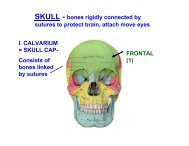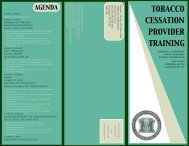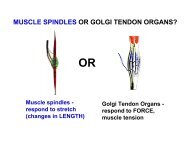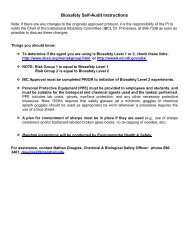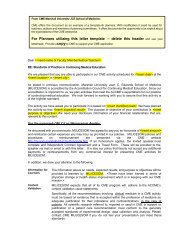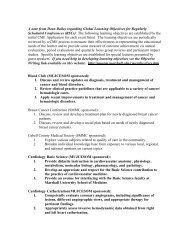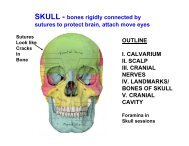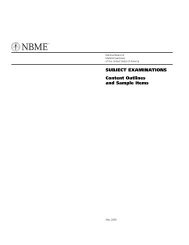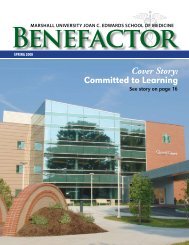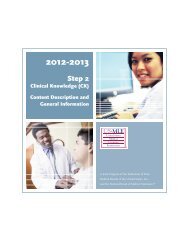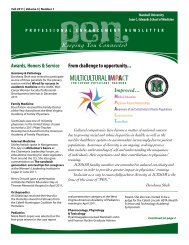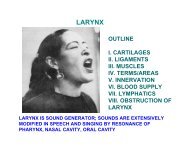Program Director/Principal Investigator (Last, First, Middle): Rankin, Gary O 56regulator within alternative macrophages (M2). Arginase mediated signaling decreases Tlymphocyte proliferation resulting in immune suppression. Markers <strong>of</strong> immune dysfunction in theearly post-stroke phase, such as the NLSF, TLR signals, arginase, and T-cell activity may proveuseful for identifying patients with increased risk <strong>of</strong> secondary complications. The mechanisms <strong>of</strong>post-stroke immune suppression will need further study and taken into account when developingstroke treatments impacting inflammatory and immune pathways.Submitted Manuscript:T. L. Barr, R. VanGilder, S. Rellick, Y. Conley, J. Ding, D. Chen, J. Denvir, A. Dillman, StevenWarach, Andrew Singleton, M. Matarin. Identification <strong>of</strong> a genomic pr<strong>of</strong>ile following ischemic strokethat may mediate stroke recovery. Submitted to Science Translational Medicine.6. Project #5:Regulation <strong>of</strong> brain endothelial phenotype and function by diabetic plasmaWe have previously identified that in the streptozotocin (STZ) model <strong>of</strong> diabetes there is a change inthe barrier properties <strong>of</strong> the brain endothelial cells that regulate both the physical and transportproperties <strong>of</strong> the blood brain barrier (BBB). These changes in BBB properties are prolonged andeventually become resistant to insulin therapy. Similar functional changes at the BBB have beenreported clinically. During diabetes there are a number <strong>of</strong> changes that occur in the blood. Severalfactors that change clinically are known regulators <strong>of</strong> BBB function, though their role in regulation <strong>of</strong>the diabetic BBB is unknown. Our current working hypothesis is that diabetes induces changes insignaling molecules within the blood that can in turn regulate both the phenotype and function <strong>of</strong> thebrain cerebromicrovasculature. Thus, the aim <strong>of</strong> this study is to investigate what role constituents<strong>of</strong> blood play in the regulation <strong>of</strong> BBB function in an animal model <strong>of</strong> diabetes.Specific Aim 1: Investigate changes in gene expression in brain microvasculature endothelial cellsin an animal model <strong>of</strong> diabetes.In our earlier ACORN report, we reported on our studies investigating the effects <strong>of</strong> STZ on barrierfunction <strong>of</strong> cerebral microvasculature. Our focus in this study was investigating the changes in theexpression <strong>of</strong> mRNA and proteins involved in VEGF and its signaling, at the blood brain barrier. Wefound increases in the mRNA <strong>of</strong> most <strong>of</strong> the genes in the VEGF signaling pathway. However wedid not see a comparable increase in the levels <strong>of</strong> protein. Subsequent studies indicated that thismay be due to regulation <strong>of</strong> translation via circulating microRNA. In this report we have two followup studies:1. Are the changes in VEGF similar in other barrier vascular beds <strong>of</strong> the Brain?Our studies to date have concentrated on the BBB in the cortex <strong>of</strong> rats. During our studies weroutinely collect the Choroid plexus, another brain barrier system that is heavily regulated by VEGF.Our hypothesis is that if circulating miRNA is indeed involved in regulating barrier VEGF then weshould see similar changes at the choroid plexus.Table 1: Comparison <strong>of</strong> protein changes by Western blot at the BBB and at the choroid plexusfrom STZ treated rats. [NC, no change]Cortex BBB Choroid PlexusVEGF NC NCFlt-1 NC NCFlk-1 ↑40% ↑45%From table 1, it is apparent that for the three proteins we have looked at so far (VEGF and its twomain receptors), that the changes are similar at the choroid plexus to those seen at the BBB,indicating that there may be similar regulation <strong>of</strong> both barrier systems.2. Is there a change in VEGF receptor activation?Changes in expression though important do not necessarily represent functional changes. ThusPHS 2590 (Rev. 06/09)Continuation Format Page
Program Director/Principal Investigator (Last, First, Middle): Rankin, Gary O 57we have investigated the activation <strong>of</strong> the VEGF receptor Flk-1. There are three tyrosines on Flk-1that play an important role in regulating the downstream signaling. Phosphorylation pr<strong>of</strong>iles <strong>of</strong>these three sites dictate the signaling cascades activated by the receptor. Initially we haveinvestigated the phosphorylation <strong>of</strong> Flk-1 Tyr-1175 in both brain and choroid plexus vasculature.Though the levels <strong>of</strong> expression for the Flk-1 were similar (increased by 40 and 45% in BBB andchoroid plexus respectively), we saw a marked difference in activation. In the BBB phosphorylation<strong>of</strong> Tyr-1175 was reduced by 40% compared to control BBB. In contrast the choroid plexus Flk-1Tyr-1175 was increased by 35% compared to non-diabetic animals. These tissues were isolatedfrom the same animals. This indicates that there is a differential activation <strong>of</strong> the receptors in thesetwo barrier systems <strong>of</strong> the brain. Tyr-1175 phosphorylation is involved in VEGFs activation <strong>of</strong> PLC,PI3K and <strong>FA</strong>K, key signaling cascades related to angiogenesis and cell survival.For this specific aim we are also still working on producing high quality RNA for the gene analysisstudies. We have discussed protocols with other BBB researchers and hope to have high qualitymicro vessel RNA preparations in the near future.Specific Aim 2: Investigate the role <strong>of</strong> plasma signaling molecules in brain microvascular changes.We have held <strong>of</strong>f on these studies as we would like to use cells that are treated with the plasmafrom the animals that we carry out the array studies on.Potential <strong>WV</strong>U interactions: Based on our studies with the ACORN grant we have started todiscuss collaborations with two investigators at <strong>WV</strong>U, Taura Barr (another ACORN investigator)and Jason Huber. This collaboration would not have been possible without the <strong>INBRE</strong> or ACORNgrants.7. Student Participation in ACoRN Projects:During Y11, undergraduate students worked on ACoRN research projects in labs at West LibertyUniversity (WLU) and Marshall University. Two undergraduate students (Stan Guertal and EthanKobe) worked in Dr. Robert Kreisberg’s lab at WLU on Project #1 (SPID #26). Three undergraduatestudents (Logan Efaw, Melissa Massie and Courtney Crain) worked in Dr. Nalini Santanam’s lab atMU on Project #3 (SPID #36).8. Protection against research risksProject #5 Project #41.) Will human subjects be involved next year? No YesA. IRB # N/A H-22566B. Date <strong>of</strong> IRB approval? N/A 9/20/2010C. IRB approval & Human subject education certification enclosed?N/A Yes2.) Will vertebrate animals be used next year? Yes NoA. Date <strong>of</strong> Institutional Animal Care and Use Committee (IACUC) approval, enclosed?09/16/2010, N/AB. IACUC # 459 N/AC. If no approval date, please explain: N/A N/AD. Is this IACUC approval date different from the date reported last year?N/A N/A3.) Will recombinant DNA experiment(s) be conducted next year?No NoA. Date <strong>of</strong> Office <strong>of</strong> Recombinant DNA Activities (ORDA)? N/A N/AB. EXEMPT? N/A N/APHS 2590 (Rev. 06/09)Continuation Format Page



